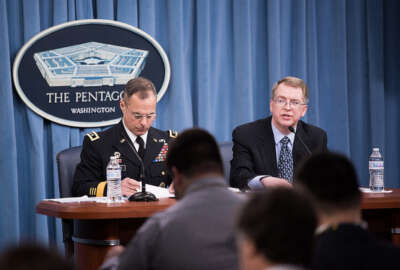
Army Research Office turns to AI for better batteries
The Army is using AI bots to break down small problems that would take humans extreme amounts of time.
The Army needs energy and in a lot of cases it gets that energy from batteries. The flaw with batteries is that they die, and carrying multiple batteries gets cumbersome. The Army Research Office is trying to change that by making more efficient fuel cells, and it’s employing artificial intelligence to do that.
There are hundreds of thousands of combinations of elements that could create a better battery, but trying each one would take forever.
That’s where AI steps in. ARO is using AI to pair together different elements quickly and tag the best combinations for humans to actually try out.
“It is about material discovery and finding the right material that has the necessary properties, Purush Iyer, division chief of network sciences at ARO told Federal News Network. “Alloys are typically formed using two or three materials. The way they can be combined is so vast that trying out every possible combination is incredibly hard.”
Ultimately, ARO scientists want to improve fuel cells by replacing the need for hydrogen — which is difficult to store — with methanol, which could be more efficient.
“These methanol-based are predicted to give you much longer cycle times than hydrogen-based fuel cells,” Iyer said.
Iyer said the goal is to double or triple battery life.
The challenge is there were no known materials for efficient catalysts for methanol oxidation.
The AI combines multiple software agents that explore certain elements and combine the results, making it easier to find the boundaries of where scientists should explore for a better battery. Since methanol oxidation needs three elements, instead of two, the number of permutations increases significantly.
ARO created a system called CRYSTAL that gives different bots small components of the problem to sift through those permutations. So far, one unique catalyst has been identified that is effective for oxidation and could be helpful in making better batteries.
“We are thinking within the next five to 10 years there might be movement,” Iyer said. “There is a dual purpose to this work. It not only establishes that this fuel cell work can be done, but it also establishes that AI is usable in areas that people don’t usually think of like material design and other engineering problems. What it illustrates is that it’s usable and could provide great savings if the problems are pared down and broken up into pieces that are appropriate for AI. AI isn’t just some fairy dust or gold dust that you can sprinkle over and things happen.”
ARO’s work on batteries is staffed by universities. It worked with Cornell University to create the AI bots that could work within material science.
Outside of the ARO, the Defense Department is putting a lot of stock into technologies like AI.
The 2019 budget put a heavy emphasis on future technologies like AI and machine learning.
“Part of the nature of the changing environment is the importance of staying in front of the technology changes and the evolving threats as it expands across a number of different domains and so our research program reflects that,” then-DoD Comptroller and current Deputy Defense Secretary David Norquist said during the 2019 defense budget roll out. “This spread [of research investment] shows the domains that we are operating in and how our enemies are attempting to operate. And the challenge has expanded and we need to be able to address those.”
The 2020 budget request put even more funds into those technologies. The request for 2020 asked Congress for almost $104 billion for its research, development, test and evaluation fund. The request is $8 billion more than what was allocated in 2019 and $12 billion more than what was given to the DoD for the account in 2018.
Copyright © 2025 Federal News Network. All rights reserved. This website is not intended for users located within the European Economic Area.
Scott Maucione is a defense reporter for Federal News Network and reports on human capital, workforce and the Defense Department at-large.
Follow @smaucioneWFED
Related Stories





